
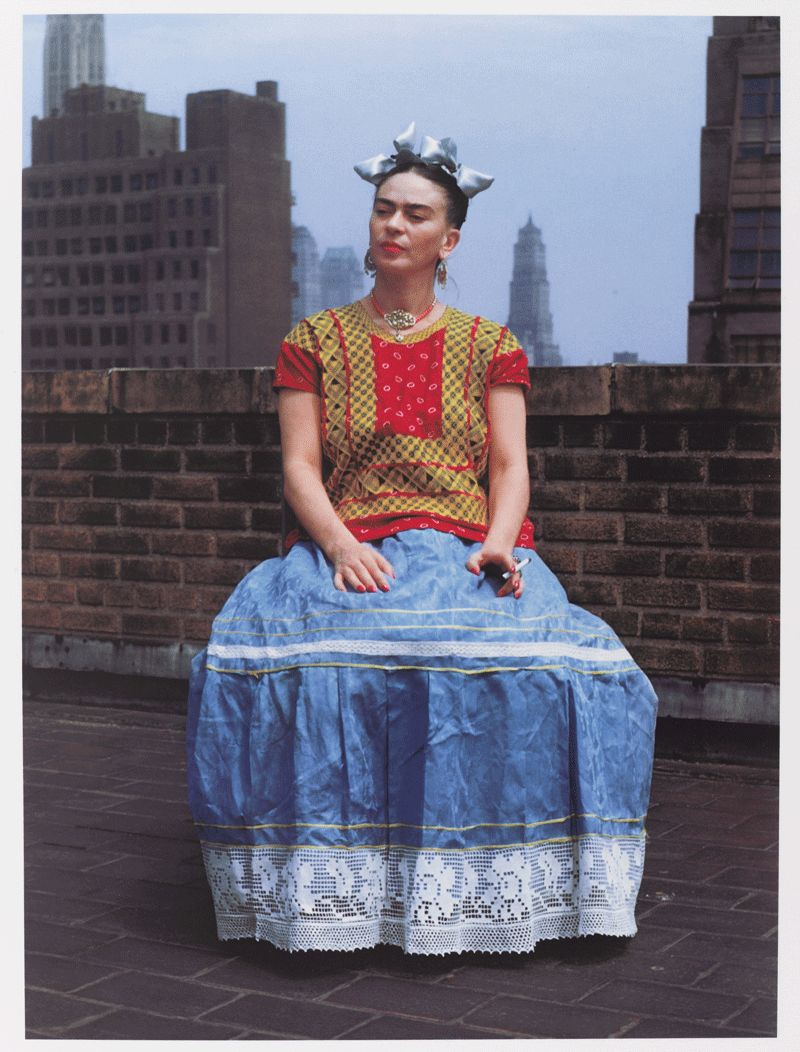
Nickolas Muray (American, born Hungary, 1892–1965). Frida in New York, 1946; printed 2006. Carbon pigment print, image: 14 x 11 in. (35.6 x 27.9 cm). Brooklyn Museum; Emily Winthrop Miles Fund, 2010.80. Photo by Nickolas Muray, © Nickolas Muray Photo Archives. (Photo: Brooklyn Museum)
Appearances Can Be Deceiving
Frida Kahlo Defines Herself in Brooklyn
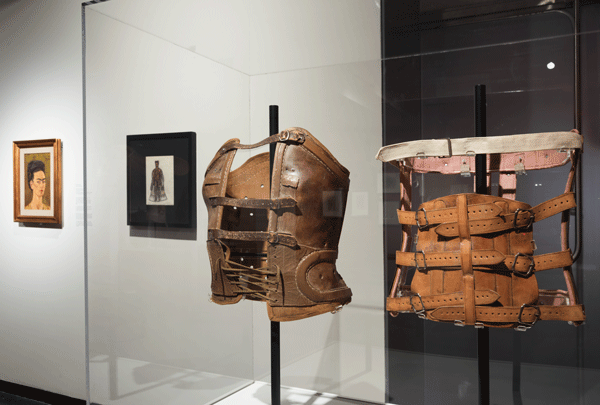
Installation view, Frida Kahlo: Appearances Can Be Deceiving, Brooklyn Museum, February 8 – May 12, 2019 (Photo: Jonathan Dorado)
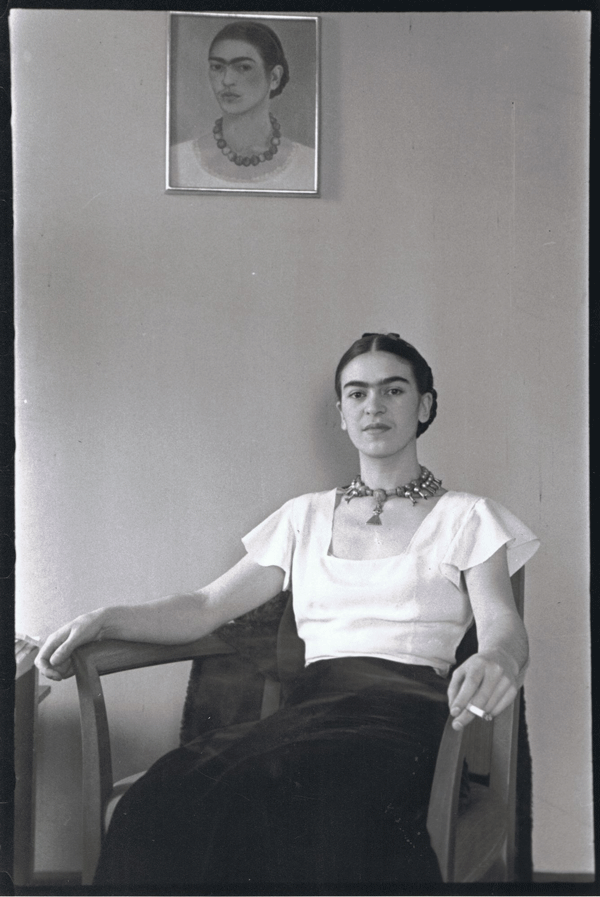
Lucienne Bloch (1909-1999), Frida Kahlo at the Barbizon Plaza Hotel, New York, 1933. Black and white photograph, 21 x 17 in. (53.5 x 43.2 cm). The Jacques and Natasha Gelman Collection of the 20th Century Mexican Art and the Vergel Foundation. © Lucienne Allen dba Old Stage Studios. (Image courtesy of Old Age Studios)
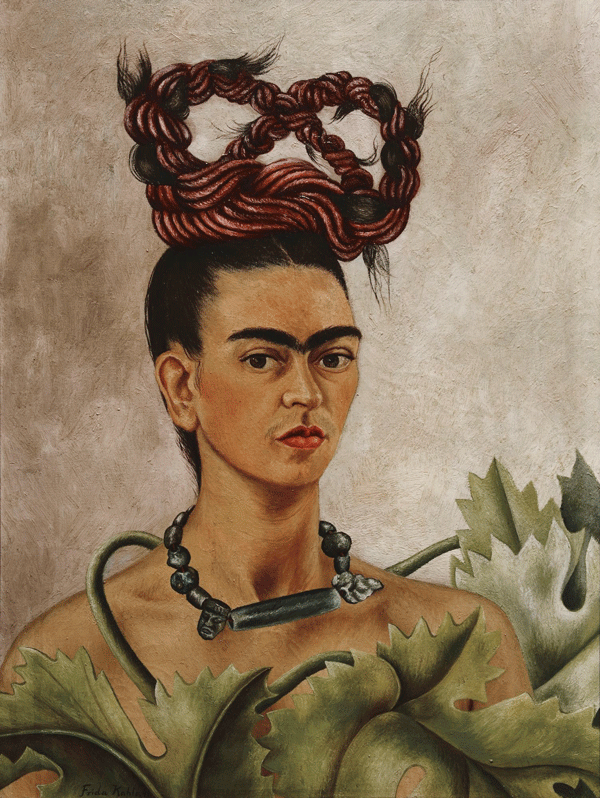
Frida Kahlo (Mexican, 1907–1954). Self-Portrait with Braid, 1941. Oil on hardboard, 20 x 15 ¼ in. (51 x 38.5 cm). The Jacques and Natasha Gelman Collection of 20th Century Mexican Art and the Vergel Foundation. © 2018 Banco de México Diego Rivera Frida Kahlo Museums Trust, Mexico, D.F. / Artists Rights Society (ARS), New York
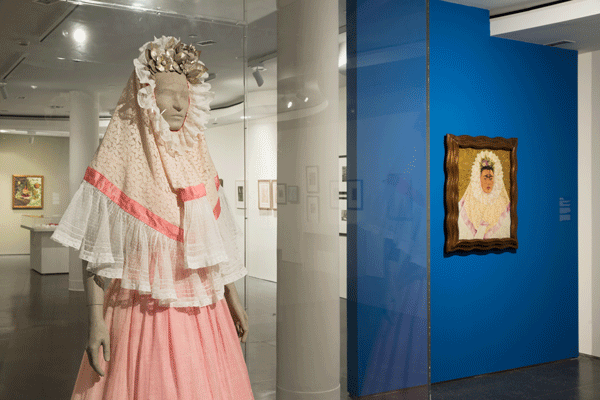
Installation view, Frida Kahlo: Appearances Can Be Deceiving, Brooklyn Museum, February 8 – May 12, 2019 (Photo: Jonathan Dorado)
On February 5th, 2019, when the 116th Congress met for the State of the Union Address, the Democratic women in congress wore suffragette white. The employment of carefully curated art and fashion to disrupt the cultural norms and orchestrate the building of cultural bridges has a long history in the US and beyond. Mexican artist and cultural icon Frida Kahlo knew about taking a stand for herself and others through identity and politics. Indeed, she knew that appearances can be deceiving.
Frida Kahlo: Appearances Can Be Deceiving features the U.S. debut of more than one hundred of Frida’s personal belongings. These intimate objects explore the artist’s life and work and are presented in conjunction with other works of art, with a myriad of public and educational programs, including bilingual exhibition text and pop up talks, events, a screening of the film, Frida, Kahlo-inspired Mexican food offerings, a free Community Day, and a Viva Frida Kahlo Dance Party.
I recall studying Kahlo’s work in college. After slides and pages and lectures and presentations on what we then called DWEMs, Dead White European Male artists, the probable sole paragraph on Kahlo was a breath of fresh air and a bright light. She showed me what was possible when we construct our own personal narratives. Within the exhibition, I was transported by the work to a space fully whole of the human condition, full of pain, loss, celebration, love, family, friends, society, and more. While I appreciate seeing the numerous paintings, drawings, and photographs—media we typically experience in art museums—it is the range of visual culture from her life that reveal a deeper sense of her Latinx inspiration.
“The prevailing narrative that women are too often defined by their clothes, their appearance, and their beauty was powerfully co-opted by Kahlo through the empowering and intentional choices she made to craft her own identity,” says Catherine Morris, Sackler Senior Curator for the Elizabeth A. Sackler Center for Feminist Art, Brooklyn Museum.
Locked away until 2004 in La Casa Azul—her blue house in Mexico City that now serves as The Frida Kahlo Museum—there are numerous personal items of Frida’s on view such as her iconic Tehuana clothing, jewelry, make up, various accessories, and prosthetics, including hand-painted plaster-corsets worn during her lifetime. This multimedia exhibition also incorporates drawings and 11 key paintings by Kahlo; photographs of Kahlo and her husband she married twice, Diego Rivera, by renowned international photographers including her father, and related historical films. The breadth and depth of this exhibition offers insight into how she created her personal and public identity to intentionally empower her gender, heritage, and political beliefs, while simultaneously controlling how she managed the appearance of her physical disabilities from childhood polio and a bus accident which broke her spine.
Some of her most iconic works are on view, including Self-Portrait with Necklace (1933), Self-Portrait with Braid (1941), and Self-Portrait as a Tehuana, Diego on My Mind (1943). The curators, Morris along with Lisa Small, Senior Curator, European Art, Brooklyn Museum, have fashioned an interesting contextualized presentation featuring ten thematic areas and thoughtful juxtapositions. Some displays of particular interest are pieces of Kahlo’s clothing displayed directly adjacent to a self-portrait where she is depicted in that same clothing.
For me, one of the most powerful experiences in the exhibition was the opportunity to see up-close the hand-painted plaster-corsets she would have worn after enduring one of her more than thirty surgeries. In several of the corset-casts, she delicately depicts different versions of a fetus: Kahlo was not able to have children, although she and Rivera tried. Here, there is a moving narrative about love and loss on an exceptionally intimate object. I wondered whether she ever imagined these would be shown publicly.
A traditional display of only her paintings and drawings no doubt would have provided positive praise and press, an increase in museum attendance, membership and gift shop sales (I mean, who doesn’t want a poster, earrings, coaster, coffee mug, or hundreds of other objects adorned with Frida!?). However, this distinct multimedia approach provides a relevant narrative for inter-generational and multicultural audiences who appeal to their leaders to take action on issues like diversity, inclusion, and equity. Moreover, considering that a form of this exhibition started at the Frida Kahlo Museum in Mexico, was expanded on and presented at the Victoria and Albert Museum in London, and was then contributed to by the Banco de México Diego Rivera and Frida Kahlo Museums Trust, The Gelman Collection of 20th Century Mexican Art, and the Vergel Foundation for Brooklyn, is noteworthy and also reveals a meaningful subtext of collaboration in the creation of the exhibition.
“Focused on the life and work of Frida Kahlo, the show comes at an important time, when it is critical to build cultural bridges between the United States and Mexico,” says Anne Pasternak, Shelby White and Leon Levy Director, Brooklyn Museum.
Taking the case that international politics and ensuing negotiations can be supportive, direct, and timely, this collaboration among museums is demonstrative of possibility. And in a political season and era when some leaders are considering building, instead of tearing down, walls, this exhibition serves as a reminder that artists and art remain at the forefront of representing positive paths forward.
As an art museum educator, I am interested in also exploring how museums collaborate with diverse audiences to expand relationships to culture, art, artists, and one another. Toward that end, the Brooklyn Museum has a long-standing relationship with Cool Culture, an organization striving to provide access for historically marginalized schools and families, of which 40% are Latinx, to museums and other cultural organizations in New York City. This spring they will partner for the Museum’s Frida Kahlo Community Day on April 28th, to offer families free admission to the exhibition, says Sandra Nanita, Assistant Director of Programs for Cool Culture. They plan to use multi-language promotional strategies and are excited about the natural connections between the exhibition and their innovative programming. “Our intent is to support communities in using art as a tool to shift the existing narratives about their cultural identity to be more representative of who they are,” shares Nanita.
Frida Kahlo: Appearances Can Be Deceiving is on view at the Brooklyn Museum through May 12. The exhibition says adios with a dance party on May 10th, 8-11pm, featuring dancing, musical tributes, art-making with the Latinx art collective, Collective Cósmica, and DJ sets by Chulita Vinyl Club.
Elizabeth B Reese, PhD, is a mother, independent museum and wellness educator, and freelance writer. As the founder of Yogiños: Yoga for Youth®, she has authored award-winning, bilingual resources for kids, teachers, parents, and families.
Alex Nogales
Tanya Suarez Tigner